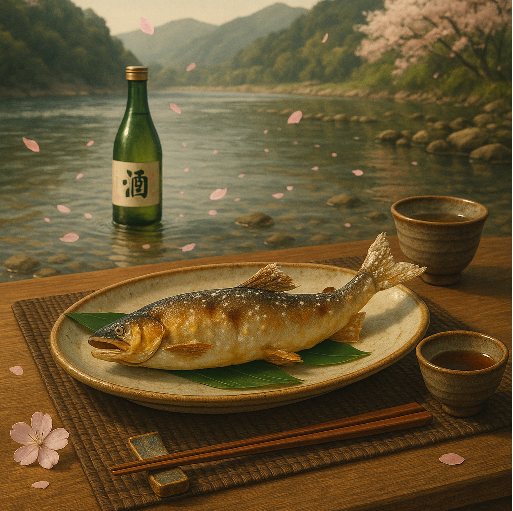
May 10, 2025
Although Ayu—also known as sweetfish—is not strictly endemic to Japan, it is deeply tied to the nation’s rivers and seasonal traditions. One of the most iconic rivers associated with Ayu is the Nagara River in Gifu Prefecture, renowned for its crystal-clear waters and ancient cormorant fishing technique called ukai. Every spring, the arrival of juvenile Ayu swimming upstream marks the beginning of early summer in Japan.
This year, Ayu migration through the Nagara River Estuary Barrage has reached over one million fish—making it one of the most impressive seasons since monitoring began. Officials remain unsure why the numbers are so high, but they remain optimistic and hope that many more fish will continue to return.
For those unfamiliar with Ayu beyond its ecological role, this humble fish is also a prized seasonal delicacy in Japan. It thrives only in clean, clear rivers, and its flavor is as delicate and refined as its environment. Ayu are typically grilled with a pinch of salt (shioyaki), and one of the most distinctive aspects of this fish is that you can eat it whole—yes, even the innards.
That’s because Ayu feed exclusively on algae and moss in the river, which gives their flesh a pure, subtle taste and their innards a slightly bitter flavor that many Japanese gourmets find exquisite. In fact, appreciating the bitterness of ayu no harawata (the fish’s guts) is considered a mark of a true connoisseur.
Ayu also pairs beautifully with sake, making it a popular feature in traditional summer meals, especially in rural inns and riverside restaurants.
If you’re someone who loves Japan and wants to experience its nature, culture, and cuisine more deeply, why not challenge yourself to try grilled Ayu on your next visit? It might just become one of your favorite hidden gems of Japanese food.
100万匹以上のアユ:日本・長良川の記録的な春
2025.5.10
アユ(スイートフィッシュとしても知られています)は、厳密には日本固有種ではありませんが、日本の河川や季節の伝統と深く結びついています。アユと最も象徴的に関係している川のひとつが岐阜県の長良川で、そこは澄んだ水と、鵜飼と呼ばれる古代の鵜による漁法で知られています。毎年春になると、稚アユが上流へと泳ぎ始める姿が、日本で初夏の到来を告げるものとなっています。
今年、長良川河口堰を通じたアユの遡上数が100万匹を超え、観測が始まって以来最も印象的なシーズンのひとつとなりました。なぜ今年これほど多くの魚が遡上しているのかは明らかではありませんが、関係者たちは楽観的であり、さらに多くの魚が戻ってくることを期待しています。
アユが生態系における役割を超えて、日本でどのように捉えられているのかを知らない人のために補足すると、この質素な魚は日本で季節の美味としても高く評価されています。アユは清らかで澄んだ川にしか生息できず、その味はその環境と同じくらい繊細で上品です。アユはたいてい、塩を少し振って焼かれる「塩焼き」で提供されますが、この魚の最も特異な点のひとつは、頭から尾、内臓まですべて食べることができるということです。
これは、アユが川の中の苔や藻しか食べないためで、その結果、肉の味は純粋で淡白であり、内臓にはわずかに苦味が感じられます。この「アユのはらわた(内臓)」の苦味を美味と感じるのは、日本人の中でも食通とされる人たちの特徴です。
アユはまた、日本酒との相性も抜群で、特に田舎の旅館や川沿いの料理屋では、夏の伝統的な食事の定番ともなっています。
もしあなたが日本を愛し、その自然、文化、料理をより深く体験したいと思っているなら、次回の訪日時にアユの塩焼きに挑戦してみてはいかがでしょうか? それは、日本食の中でも隠れた名品のひとつになるかもしれません。
